Learning Module 01A – Algebraic Essentials & Linear Equations
Linear Equations in One Variable
Learning Objectives
In this section you will:
- Define algebraic equations.
- Solve equations in one variable algebraically.
- Find a linear equation.
- Given the equations of two lines, determine whether their graphs are parallel or perpendicular.
- Write the equation of a line parallel or perpendicular to a given line.
Caroline is a full-time college student planning a spring break vacation. To earn enough money for the trip, she has taken a part-time job at the local bank that pays ![]() /hr, and she opened a savings account with an initial deposit of
/hr, and she opened a savings account with an initial deposit of ![]() on January 15. She arranged for direct deposit of her payroll checks. If spring break begins March 20 and the trip will cost approximately
on January 15. She arranged for direct deposit of her payroll checks. If spring break begins March 20 and the trip will cost approximately ![]() , how many hours will she have to work to earn enough to pay for her vacation? If she can only work 4 hours per day, how many days per week will she have to work? How many weeks will it take? In this section, we will investigate problems like this and others, which generate graphs like the line below,
, how many hours will she have to work to earn enough to pay for her vacation? If she can only work 4 hours per day, how many days per week will she have to work? How many weeks will it take? In this section, we will investigate problems like this and others, which generate graphs like the line below,

Solving Linear Equations in One Variable
A linear equation is an equation of a straight line, written in one variable. The only power of the variable is 1. Linear equations in one variable may take the form, ![]() , and are solved using basic algebraic operations.
, and are solved using basic algebraic operations.
Linear Equation in One Variable
A linear equation in one variable can be written in the form
where a and b are real numbers and ![]() .
.
How To
Given a linear equation in one variable, use algebra to solve it.
The following tasks are used to manipulate an equation and isolate the unknown variable. There is no set order, as the steps used depend on what is given:
- We may add, subtract, multiply, or divide an equation by a number or an expression as long as we do the same thing to both sides of the equal sign. Note that we cannot divide by zero.
- Apply the distributive property as needed.
- Isolate the variable on one side of the equation.
- When the variable is multiplied by a coefficient in the final stage, multiply both sides of the equation by the reciprocal of the coefficient.
We begin by classifying linear equations in one variable as one of three types: identity, conditional, or inconsistent. An identity equation is true for all values of the variable. Here is an example of an identity equation.
The solution set consists of all values that make the equation true. For this equation, the solution set is all real numbers because any real number substituted for ![]() will make the equation true.
will make the equation true.
A conditional equation is true for only some values of the variable. For example, if we are to solve the equation, ![]() , we have the following:
, we have the following:
![]()
![]()
![]()
![]()
![]()
![]()
![]()
The solution set consists of one number: ![]() . It is the only solution and, therefore, we have solved a conditional equation.
. It is the only solution and, therefore, we have solved a conditional equation.
An inconsistent equation results in a false statement. For example, if we are to solve ![]() we have the following:
we have the following:
![]()
![]()
![]()
![]()
![]()
![]()
Since ![]() there is no solution and this is an inconsistent equation.
there is no solution and this is an inconsistent equation.
Solving linear equations in one variable involves the fundamental properties of equality and basic algebraic operations. A brief review of those operations follows.
Algebraic Equations
An equation is two expressions connected by an equal sign.
A solution of an equation is a value of a variable that makes a true statement when substituted into the equation.
A solve an equation mean to find the solution.
An identity equation is true for all values of the variable
A conditional equation is true for only some values of the variable.
An inconsistent equation results in a false statement.
Solving an Equation in One Variable
Solve the following equation: ![]()
Show Solution
This equation can be written in the form, ![]() , by subtracting
, by subtracting ![]() from both sides. However, we may proceed to solve the equation in its original form by performing algebraic operations.
from both sides. However, we may proceed to solve the equation in its original form by performing algebraic operations.
![]()
![]()
![]()
![]()
![]()
![]()
![]()
![]()
![]()
![]()
![]()
This is a conditional equation and the solution is 6.
Try It
Solve the linear equation in one variable: ![]()
Show Solution
![]()
Solving an Equation Algebraically When the Variable Appears on Both Sides
Solve the following equation: ![]()
Show Solution
Notice that this problem requires the distributive property to be applied twice, and then the properties of algebra are used to reach the final answer.
Let’s simplify the left side first:
![]()
Analysis
This problem requires the distributive property to be applied twice, and then the properties of algebra are used to reach the final line ![]()
Try It
Solve the equation in one variable: ![]()
Show Solution
![]()
Finding a Linear Equation
Perhaps the most familiar form of a linear equation is the slope-intercept form, written as ![]() , where
, where ![]() , and
, and ![]() . Let us begin with the slope.
. Let us begin with the slope.
The Slope of a Line
The slope of a line refers to the ratio of the vertical change in y over the horizontal change in x between any two points on a line. It indicates the direction in which a line slants as well as its steepness. Slope is sometimes described as rise over run.
If the slope is positive, the line slants to the right. If the slope is negative, the line slants to the left. As the slope increases, the line becomes steeper. Some examples are shown in in the graph below. The lines indicate the following slopes: ![]() ,
, ![]() , and
, and ![]() .
.

The Slope of a Line
The slope of a line, m, represents the change in y over the change in x. Given two points,![]() and
and![]() the following formula determines the slope of a line containing these points:
the following formula determines the slope of a line containing these points:
![]()
Finding the Slope of a Line Given Two Points
Find the slope of a line that passes through the points![]() and
and![]()
Show Solution
We substitute the y-values and the x-values into the formula.
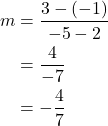
The slope is ![]() .
.
Analysis
It does not matter which point is called![]() or
or![]() As long as we are consistent with the order of the y terms and the order of the x terms in the numerator and denominator, the calculation will yield the same result.
As long as we are consistent with the order of the y terms and the order of the x terms in the numerator and denominator, the calculation will yield the same result.
Try It
Find the slope of the line that passes through the points![]() and
and![]()
Show Solution
![]()
Identifying the Slope and y-intercept of a Line Given an Equation
Identify the slope and y-intercept, given the equation![]()
Show Solution
As the line is in ![]() form, the given line has a slope o f
form, the given line has a slope o f![]() . The y-intercept is determined by
. The y-intercept is determined by ![]() , so the y-intercept is
, so the y-intercept is ![]() .
.
Analysis
The y-intercept is the point at which the line crosses the y-axis. On the y-axis, ![]() . We can always identify the y coordinate of the y-intercept when the line is in slope-intercept form, as it will always equal b. Or, just substitute
. We can always identify the y coordinate of the y-intercept when the line is in slope-intercept form, as it will always equal b. Or, just substitute ![]() . and solve for y.
. and solve for y.
The Point-Slope Formula
Given the slope and one point on a line, we can find the equation of the line using the point-slope formula.
This is an important formula, as it will be used in other areas of college algebra and often in calculus to find the equation of a tangent line. We need only one point and the slope of the line to use the formula. After substituting the slope and the coordinates of one point into the formula, we simplify it and write it in slope-intercept form.
The Point-Slope Formula
Given one point and the slope, the point-slope formula will lead to the equation of a line:
Finding the Equation of a Line Given the Slope and One Point
Write the equation of the line with slope ![]() and passing through the point
and passing through the point ![]() . Write the final equation in slope-intercept form.
. Write the final equation in slope-intercept form.
Show Solution
Using the point-slope formula, substitute![]() for m and the point
for m and the point![]() for
for![]()

Analysis
Note that any point on the line can be used to find the equation. If done correctly, the same final equation will be obtained.
Try It
Given ![]() , find the equation of the line in slope-intercept form passing through the point
, find the equation of the line in slope-intercept form passing through the point ![]() .
.
Show Solution
![]()
Finding the Equation of a Line Passing Through Two Given Points
Find the equation of the line passing through the points ![]() and
and ![]() . Write the final equation in slope-intercept form.
. Write the final equation in slope-intercept form.
Show Solution
First, we calculate the slope using the slope formula and two points.

Next, we use the point-slope formula with the slope o f![]() and either point. Let’s pick the point
and either point. Let’s pick the point ![]() for
for ![]() .
.

In slope-intercept form, the equation is written as ![]()
Analysis
To prove that either point can be used, let us use the second point ![]() and see if we get the same equation.
and see if we get the same equation.
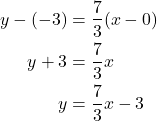
We see that the same line will be obtained using either point. This makes sense because we used both points to calculate the slope.
Standard Form of a Line
Another way that we can represent the equation of a line is in standard form. Standard form is given as
where ![]() ,
, ![]() , and
, and ![]() are integers. The
are integers. The ![]() and
and ![]() terms are on one side of the equal sign and the constant term is on the other side.
terms are on one side of the equal sign and the constant term is on the other side.
Finding the Equation of a Line and Writing It in Standard Form
Find the equation of the line with ![]() , and passing through the point
, and passing through the point ![]() . Write the equation in standard form.
. Write the equation in standard form.
Show Solution
We begin using the point-slope formula.

From here, we multiply through by 2, as no fractions are permitted in standard form, and then move both variables to the left aside of the equal sign and move the constants to the right.

This equation is now written in standard form.
Try It
Find the equation of the line in standard form with slope ![]() and passing through the point
and passing through the point ![]() .
.
Show Solution
![]()
Vertical and Horizontal Lines
The equations of vertical and horizontal lines do not require any of the preceding formulas, although we can use the formulas to prove that the equations are correct. The equation of a vertical line is given as
where c is a constant. The slope of a vertical line is undefined, and regardless of the y-value of any point on the line, the x-coordinate of the point will be c.
Suppose that we want to find the equation of a line containing the following points: ![]() , and
, and ![]() . First, we will find the slope.
. First, we will find the slope.
Zero in the denominator means that the slope is undefined and, therefore, we cannot use the point-slope formula. However, we can plot the points. Notice that all of the x-coordinates are the same and we find a vertical line through ![]() .
.
The equation of a horizontal line is given as
where c is a constant. The slope of a horizontal line is zero, and for any x-value of a point on the line, the y-coordinate will be c.
Suppose we want to find the equation of a line that contains the following set of points: ![]() , and
, and ![]() . We can use the point-slope formula. First, we find the slope using any two points on the line.
. We can use the point-slope formula. First, we find the slope using any two points on the line.
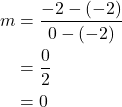
Use any point for ![]() in the formula, or use the y-intercept.
in the formula, or use the y-intercept.

The graph is a horizontal line through ![]() . Notice that all of the y-coordinates are the same.
. Notice that all of the y-coordinates are the same.

Slope of a horizontal and vertical line
The slope of a horizontal line, ![]() is
is ![]() .
.
The slope of a vertical line, ![]() is undefined.
is undefined.
Finding the Equation of a Line Passing Through the Given Points
Find the equation of the line passing through the given points: ![]() , and
, and ![]() .
.
Show Solution
The x-coordinate of both points is 1. Therefore, we have a vertical line ![]() .
.
Try It
Find the equation of the line passing through ![]() and
and ![]() .
.
Show Solution
Horizontal line: ![]()
Determining Whether Graphs of Lines are Parallel or Perpendicular
Parallel lines have the same slope and different y-intercepts. Lines that are parallel to each other will never intersect. For example, the graph below shows the graphs of various lines with the same slope ![]() .
.

All of the lines shown in the graph are parallel because they have the same slope and different y-intercepts.
Perpendicular lines intersect to form a ![]() -angle. The slope of one line is the negative reciprocal of the other. We can show that two lines are perpendicular if the product of the two slopes is
-angle. The slope of one line is the negative reciprocal of the other. We can show that two lines are perpendicular if the product of the two slopes is ![]() . For example, the graph below shows the graph of two perpendicular lines. One line has a slope of 3; the other line has a slope of
. For example, the graph below shows the graph of two perpendicular lines. One line has a slope of 3; the other line has a slope of ![]()


Graphing Two Equations, and Determining Whether the Lines are Parallel, Perpendicular, or Neither
Graph the equations of the given lines, and state whether they are parallel, perpendicular, or neither: ![]() and
and ![]() .
.
Show Solution
The first thing we want to do is rewrite the equations so that both equations are in slope-intercept form.
First equation:

Second equation:


From the graph, we can see that the lines appear perpendicular, but we must compare the slopes.
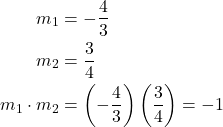
The slopes are negative reciprocals of each other, confirming that the lines are perpendicular.
Try It
Graph the two lines and determine whether they are parallel, perpendicular, or neither: ![]() and
and ![]() .
.
Show Solution
Parallel lines: equations are written in slope-intercept form.

Writing the Equations of Lines Parallel or Perpendicular to a Given Line
As we have learned, determining whether two lines are parallel or perpendicular is a matter of finding the slopes. To write the equation of a line parallel or perpendicular to another line, we follow the same principles as we do for finding the equation of any line. After finding the slope, use the point-slope formula to write the equation of the new line.
How To
Given an equation for a line, write the equation of a line parallel or perpendicular to it.
- Find the slope of the given line. The easiest way to do this is to write the equation in slope-intercept form.
- Use the slope and the given point with the point-slope formula.
- Simplify the line to slope-intercept form and compare the equation to the given line.
Writing the Equation of a Line Parallel to a Given Line Passing Through a Given Point
Write the equation of line parallel to a![]() and passing through the point
and passing through the point![]()
Show Solution
First, we will write the equation in slope-intercept form to find the slope.

The slope is ![]() . The y-intercept is
. The y-intercept is ![]() , but that really does not enter into our problem, as the only thing we need for two lines to be parallel is the same slope. The one exception is that if the y-intercepts are the same, then the two lines are the same line. The next step is to use this slope and the given point with the point-slope formula.
, but that really does not enter into our problem, as the only thing we need for two lines to be parallel is the same slope. The one exception is that if the y-intercepts are the same, then the two lines are the same line. The next step is to use this slope and the given point with the point-slope formula.
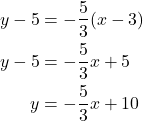
The equation of the line is ![]() .
.

Try It
Find the equation of the line parallel to ![]() and passing through the point
and passing through the point ![]() .
.
Show Solution
![]()
Finding the Equation of a Line Perpendicular to a Given Line Passing Through a Given Point
Find the equation of the line perpendicular to ![]() that passes through the point
that passes through the point ![]() .
.
Show Solution
The first step is to write the equation in slope-intercept form.

We see that the slope is ![]() . This means that the slope of the line perpendicular to the given line is the negative reciprocal, or
. This means that the slope of the line perpendicular to the given line is the negative reciprocal, or ![]() . Next, we use the point-slope formula with this new slope and the given point.
. Next, we use the point-slope formula with this new slope and the given point.
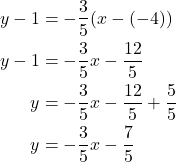
Access these online resources for additional instruction and practice with linear equations.
Key Concepts
- We can solve linear equations in one variable in the form
 using standard algebraic properties.
using standard algebraic properties. - Given two points, we can find the slope of a line using the slope formula.
- We can identify the slope and y-intercept of an equation in slope-intercept form.
- We can find the equation of a line given the slope and a point.
- We can also find the equation of a line given two points. Find the slope and use the point-slope formula.
- The standard form of a line has no fractions.
- Horizontal lines have a slope of zero and are defined as
 where
where  is a constant.
is a constant. - Vertical lines have an undefined slope (zero in the denominator), and are defined as
 where
where  is a constant.
is a constant. - Parallel lines have the same slope and different y-intercepts.
- Perpendicular lines have slopes that are negative reciprocals of each other unless one is horizontal and the other is vertical.

